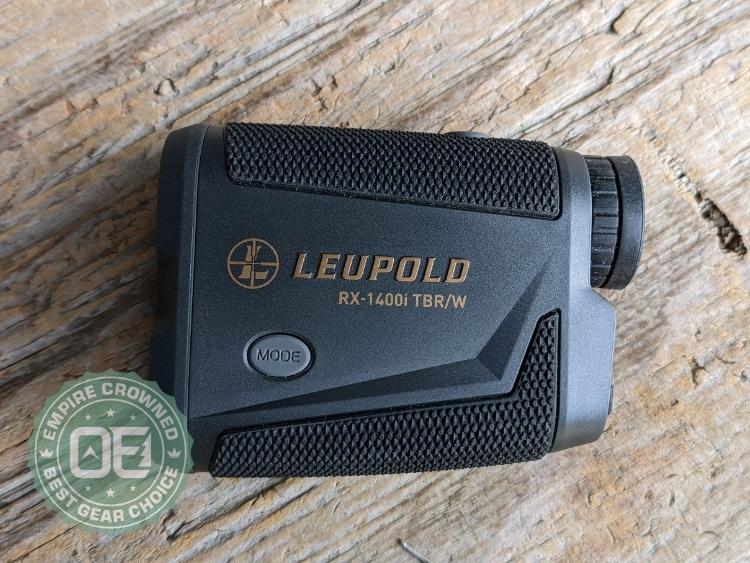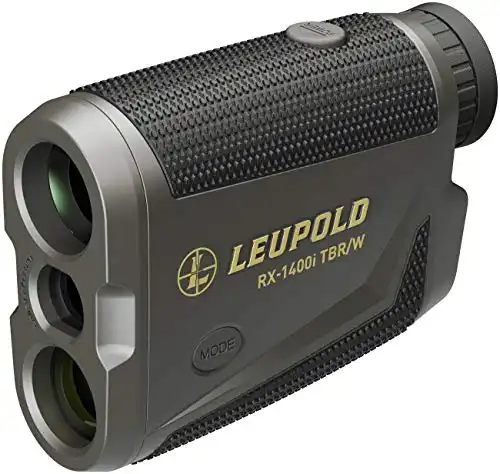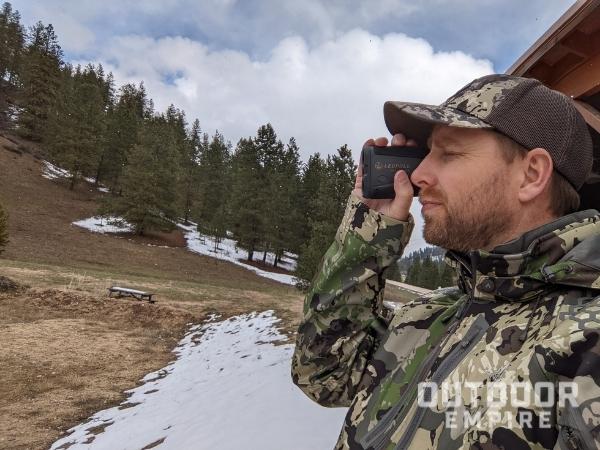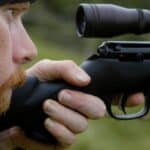There are many good options for hunting rangefinders, but I ultimately purchased the Leupold RX-1400i TBR/W, and I’ve been using it for a while now. I mainly use it for target shooting at the range and for checking distances while hunting.
After researching dozens of good options, interviewing experts at optics counters, and trying out several different rangefinders for hunting, I chose the RX-1400i because it was handily the best bang for the buck.
The Leupold RX-1400i TBR/W is relatively inexpensive but has many features found only in high-end hunting rangefinders. It performs great in low light with clear optics and a red display. While it’s not the most rugged rangefinder, the compact form factor and reliable operation make it a great buy.
- Red display is easy to see in any light condition and is unique at this price
- Easy to use and operate with solid documentation
- Sufficient range for most hunting and shooting uses
- Has more and better features than any other rangefinder for $200 or less
- Ballistics functions are great for both rifle and bow hunters
- Compact form factor and lightweight make it easy to pack around
- While waterproof, it’s not super rugged
- Only a measly 2-year limited warranty, not near as good as the competition
Compare prices at: Cabela’s, Bass Pro Shops, Sportsman’s Warehouse
I used to work in the professional measurement and land surveying industry, and so I’ve used many different laser rangefinders to do a lot of things. This has made me rather judgmental when it comes to these devices, quickly seeing through useless bells and whistles and appreciating solid core functionality.
Read on for my full explanation of why I think this is the best all around rangefinder for any pragmatic hunter.
Leupold RX-1400i Hands-On Review
At first, when I was shopping for a hunting rangefinder, I was overwhelmed by all the features and functions of all the different options available.
Many seem to push the max range, but that doesn’t matter much to me for hunting. I really just want to confirm whether or not a deer is within a couple of hundred yards since that is the distance I am most comfortable shooting at.
I’m not the best judge of distance by the naked eye, so I wanted to be able to calibrate my estimates regularly in the field with a rangefinder.
So what do I care about? Ultimately, the decision making criteria that I base my hunting rangefinder reviews on are as follows:
- Optics Quality
- Display
- Form Factor
- Ruggedness
- Features
The Leupold RX-1400i is not perfect at any of these, but it is good enough at all of them. Based on the above criteria, it compares better to the $300+ rangefinders than it does others at the same $200 price point.
Optics Quality
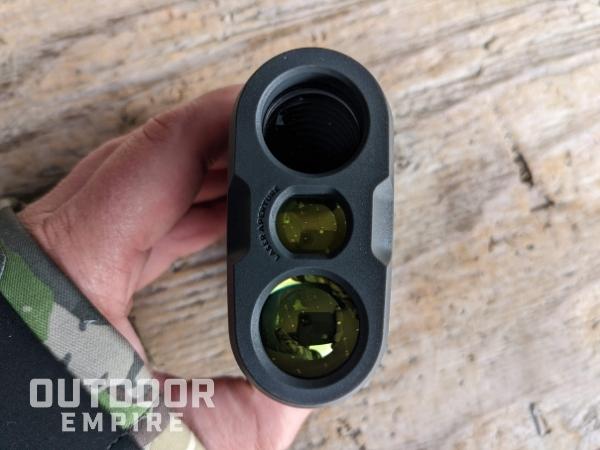
Leupold is an optics powerhouse. While the RX-1400i may not use their finest glass, I find it more than sufficient for the task of ranging critters across a draw or a target at the shooting range.
With 5x magnification and a 21mm objective lens, it is on par with other rangefinders priced between $200-$400 in terms of optics quality. And it was certainly good enough for me, even in low light conditions.
Display
When it comes to the display, there are really three things I was looking for, and this Leupold met them better than the rest.
1. Is it easy to read, even in low light?
As far as readability in low light goes, the Leupold RX-1400i was by far the best among all the rangefinders I tested that cost less than $300. With a red TOLED display and adjustable brightness settings, I could read the display in both bright midday sunlight and the low light of early dawn.
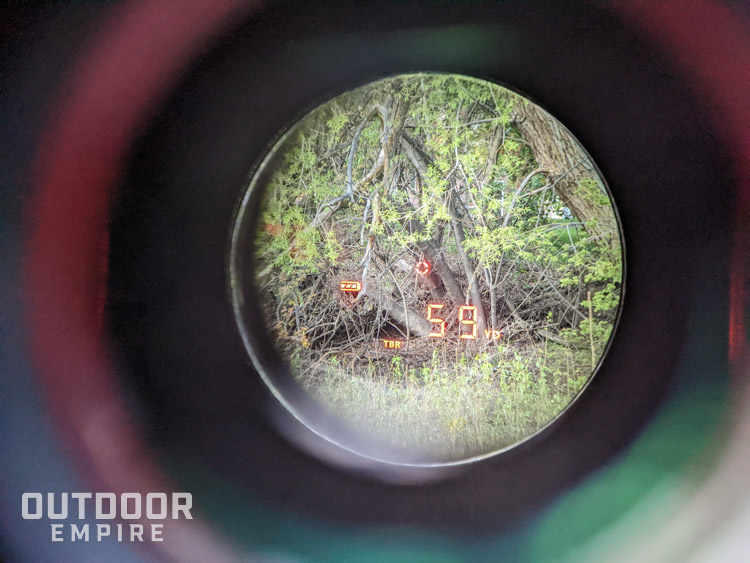
Most other rangefinders in this price range have the basic black LCD, which can be nearly impossible to read, even in moderately low light.
One downside of a red display is it can be hard to read in bright daylight. But with three brightness settings and three reticle options, you can easily adjust the display for the conditions. I thought it was good enough midday and great at dawn and dusk.
2. Is it easy to understand what you see on the display?
Some rangefinders have lots of crazy and cool but sometimes useless functionality. And those rangefinders often come with crowded, convoluted displays. Not so with the RX-1400i.
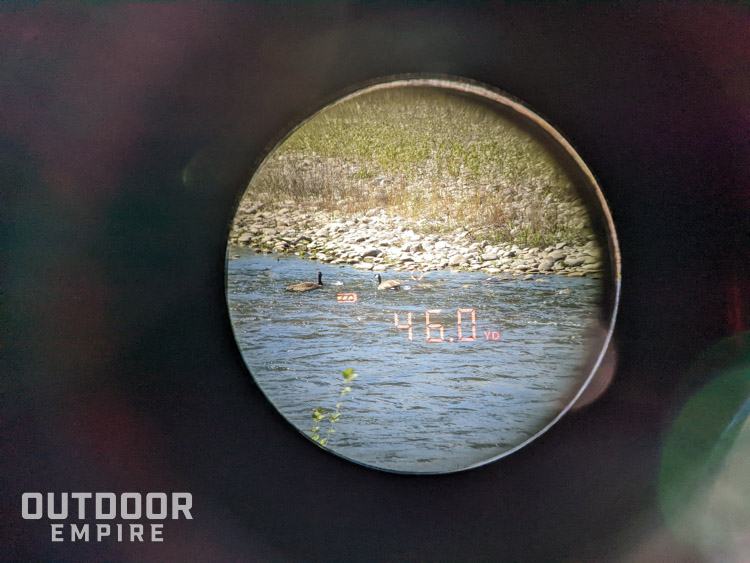
What you see is plain and simple:
- Reticle
- Battery indicator
- Distance measurement
- Unit of measurement
- Current mode
- Optional: ballistics readout or inclination, depending on mode
You see what you need to see without overly obstructing the view of what you are actually targeting.
3. Is it easy to use and navigate through the menu functions?
With only two buttons on the device, it takes a few clicks, but the navigation is relatively straightforward.
- The Power button turns it on, takes a measurement, or cycles through the selection options for each setting in the menu.
- The Mode button brings up the settings menu with a long press and cycles through different settings with a short press.
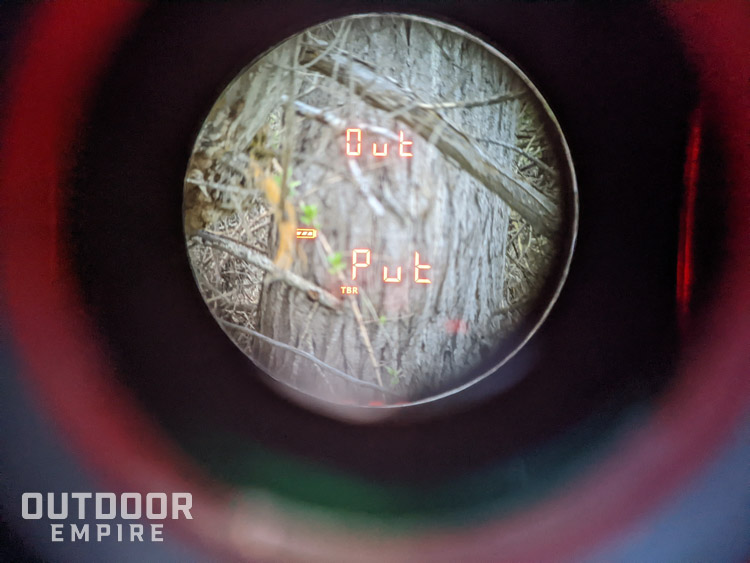
The display automatically turns off after 20 seconds, so most of the time, I only ever push the button twice: once to turn it on and once to take a distance.
I’d say it’s very easy compared to the many different recreational and professional laser rangefinders I’ve used. They even include a quick reference card that fits in the pouch that I found quite handy in the field.
Form Factor
The bottom line here is that it’s compact, lightweight, and feels good in the hand. That’s what matters and, in my opinion, the RX-1400i felt better than most.
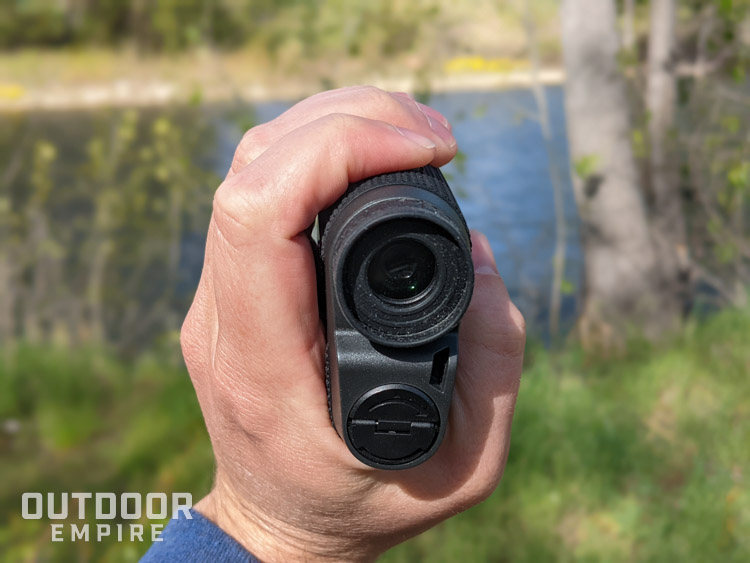
It’s not bulky and there is no fat on it. You could even slip it into or clip it onto a bino pouch or chest rig without it being a bother.
The rubberized grip is sufficient to keep you from dropping it, even when it’s wet or humid. This feature is lacking on other rangefinders under $200 that I saw, most of which have a basic plastic housing with no frills.
Its small size and weight (only 5.1 oz) make it one of the most compact in its class. I could easily stick it in my jacket or even my pants pocket when hiking around.
Ruggedness
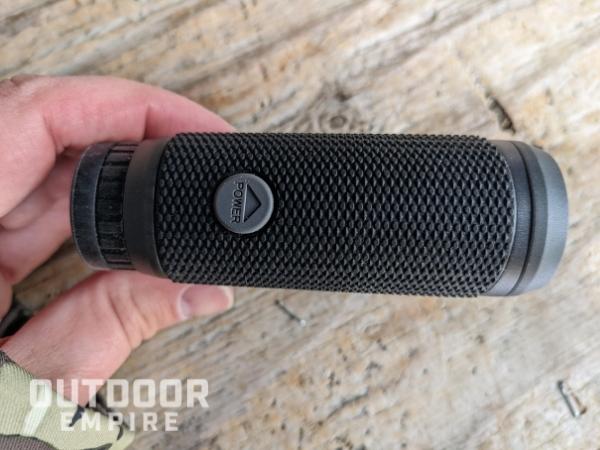
While it’s not the most rugged hunting rangefinder out there, it is good enough for me.
Apparently, it is also rated to work in extreme cold and hot temperatures. I did use it below freezing and the performance was unchanged. Though, I would expect shorter battery life in either the heat or the cold.
I would be concerned about shock or drop protection. It is a plastic housing made of a lightweight polymer. It’s not like the aluminum or magnesium housings of more expensive rangefinders, but it’s as good or better than any other in its price class.
The Leupold RX-1400i TBR/W is waterproof, so you don’t have to worry about rain, fog, or humidity. It doesn’t have any official IP (Ingress Protection) rating.

As far as dust goes, so far so good. No issues to report on dust getting inside the optic.
To get a truly ruggedized rangefinder that is fully protected from the elements and drops, you’ve got to move into a much higher price point. Better construction and materials get expensive.
Features
Where to start? The RX-1400i is packed with features compared to other budget hunting rangefinders.
Can it really range out to 1400 yards?
I never got it to range out that far. But the truth is, I don’t really care. I only need to measure out to a few hundred yards, maybe up to a thousand, if I want to estimate hiking time.
The farthest I ranged to some trees was about 980 yards (manual says max of 1200 yds) and I was happy with that.
I did test it against my favorite high-end rangefinder, the Maven RF.1. At one point, I was hitting a hillside at 1230 yards with the Maven, and the Leupold couldn’t give me a reading. Same for a range of 2500 yds, but I didn’t expect the RX-1400i to hang with that.
Recommended: Maven RF.1 Rangefinder Hands-on Review
These specs are always more mathematical, and lab estimated rather than thoroughly real-world tested. It’s the same with the professional-grade measurement equipment I’ve worked with.
What does the TBR/W stand for?
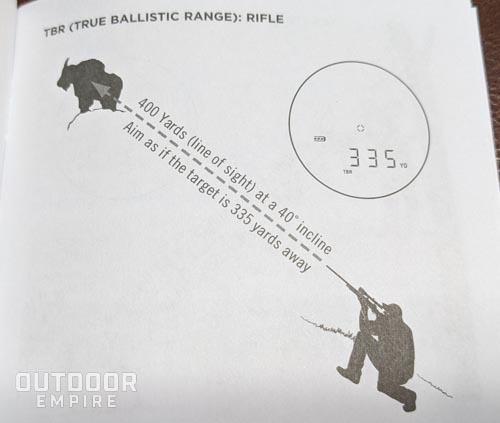
This is perhaps one of the main features of the RX-1400i that sets it apart in its class. TBR/W stands for True Ballistic Range® Wind which is Leupold’s name for some pretty cool ballistics functions.
In a nutshell, this rangefinder can tell you what distance you should aim for (level fire range) based on the cartridge and load you are shooting, even in steep terrain. It can also help you calculate the wind correction you should dial into your riflescope. Pretty cool!
3 Ranging Modes
There are three main modes for measuring the distance to a target:
1. TBR: the effective ballistics range between you and the target, adjusted for inclination. This is the distance you should consider when aiming your rifle.
2. BOW: the equivalent horizontal distance you should aim for with a bow, also adjusted for the angle.
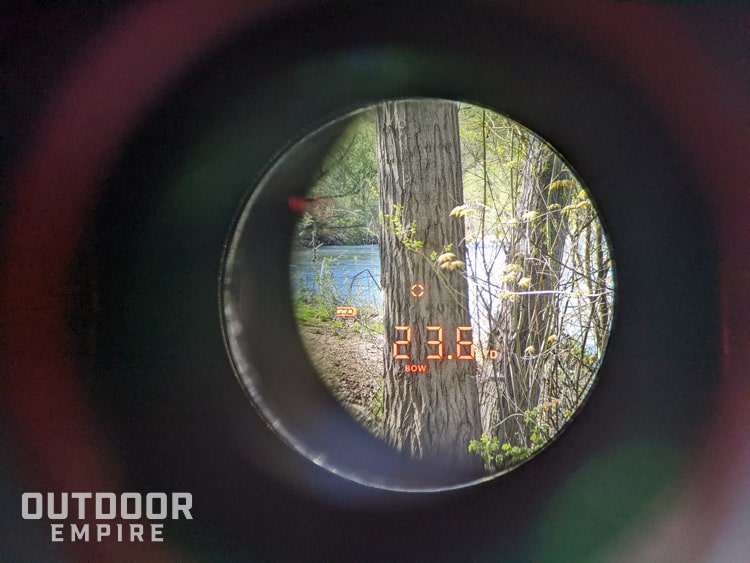
3. LOS: this is the straight line of sight distance without any angle correction or ballistics consideration.
For Rifle Hunters
In TBR mode, there are 25 different load groups you can set the rangefinder to and they include the associated calibers and loads in a detailed chart they provide. It then has five different functions that will display outputs that correspond to your selected load.
1. BAS: the equivalent horizontal range.
2. HOLD: how much holdover to use with the line of sight distance displayed and how many inches above or below the target you should aim.
3. MIL: like the above, but displays holdover in milliradians.
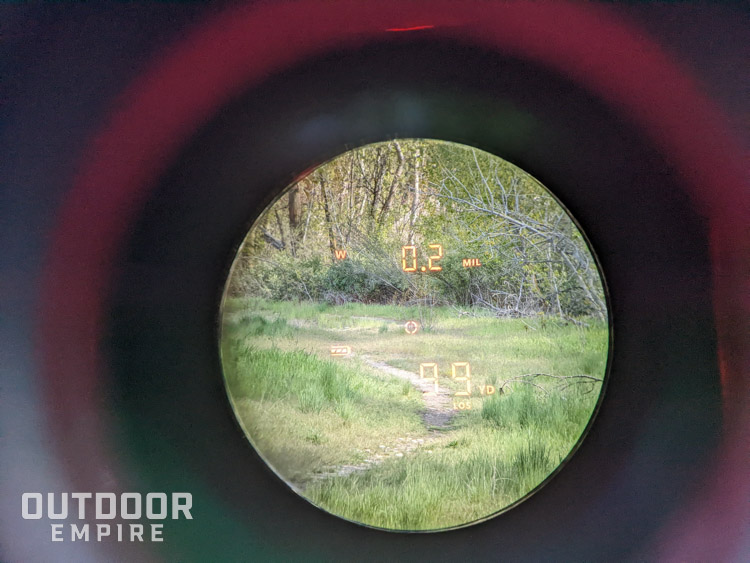
4. MOA: shows the minute-of-angle adjustment for your target so you can adjust your scope accordingly.
5. TRIG: shows true horizontal, vertical, and line of sight range so you can do the math yourself…if you’re into that sort of thing.
While I haven’t used this myself in a real-world scenario (I did test it), I appreciate the math it could save me from doing. At first, it seemed pretty complicated to me, but a quick read through the user guide and it’s actually not hard to use this feature.
Wind Mode
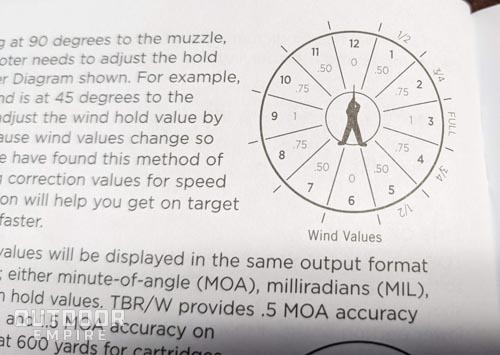
The Wind mode is interesting. It gives you an estimated MOA correction you should make if there is a 10 mph wind blowing at a 90-degree angle to your muzzle.
Since you can change those default values of wind speed and angle, you’ll still have to do some math to use this feature. But once you get the hang of it, it might save you some time to get a long-range shot off quicker because it helps you know how much to adjust your scope for wind.
Last Target Mode for Bad Weather
Another handy feature this rangefinder has is the Last Target mode. This is designed to help the laser provide accurate measurements even in foggy or rainy conditions.
The way it works is that the measurement displayed will be the last, or farthest, distance returned by the laser. Normally, the measurement you see is the strongest return the laser receives.
However, when in Last Target mode, it simply displays the last measurement which should be the farthest and is often the weakest object in terms of reflectivity.
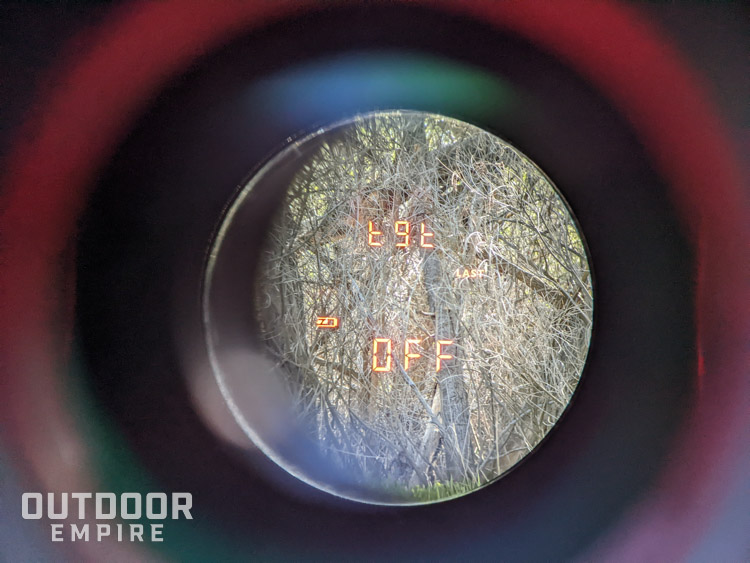
This helps in moist air because it is supposed to filter out many potential reflections of water particles in the air from rain, fog, snow, etc.
One day at the range, I had all four seasons, including rain and snow. The rangefinder worked great at distances of 100 yards or less, even with large snowflakes and light rain. I can’t say from experience how it would do in dense fog, but I think this feature is useful.
The Last mode could even help in a dense forest with lots of branches through which you might be trying to range a whitetail.
Leupold RX-1400i Compared to the Alternatives
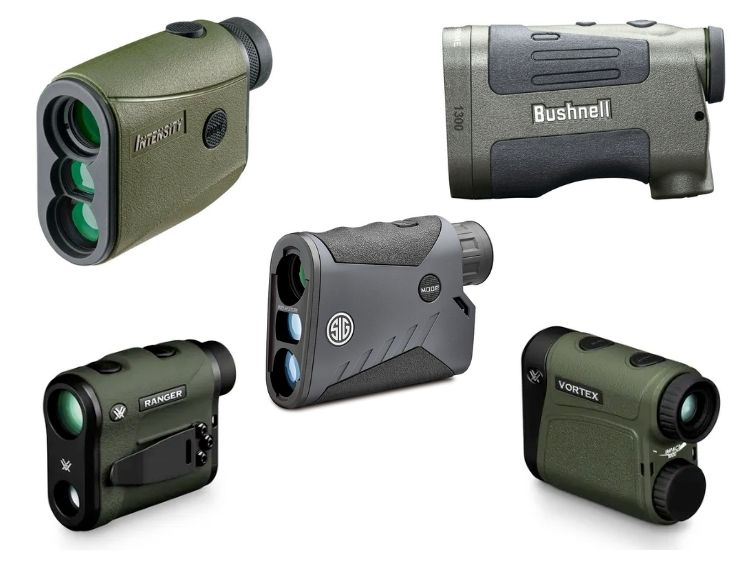
While it’s an entry-level product from Leupold, the RX-1400i has the functionality of mid-range options from competitors. However, in the same price range and class, the following are the main rivals I compared.
Cabela’s Intensity 1600R Laser Rangefinder: This is the only other rangefinder I found in the same price range that had a red display. However, it is a little bulkier, and it just feels like it’s of lower quality, cheap almost. It has very basic features and functions, none of the ballistics info, and not the best user reviews, so I ruled it out.
Bushnell Prime 1300 Rangefinder: This is a tad cheaper than the Leupold. The look and feel are on par with the RX-1400i, and it has better magnification (6x). It even has an Angle Range Compensation mode, though it’s not as advanced as the TBR. But it doesn’t have the red display, which is something I was pretty set on.
Vortex Impact 1000 Rangefinder: This is the first one I was leaning towards in large part due to the great brand reputation and the fact that I have other Vortex optics.
But it has a black LCD that is hard to see, none of the ballistics features, it doesn’t feel as good in the hand, and its range is more limited than the RX-1400i for the same price. The lifetime warranty, however, is better than Leupold’s two years.
Sig Sauer KILO 1000BDX Rangefinder: At the same price, this one probably comes closest to the Leupold, but it’s still not quite there. It has a shorter range (though its big brothers can solve that), reportedly short battery life, and that darned black LCD.
While it doesn’t have the onboard ballistics calculations of the RX-1400i, it does connect to the Sig Sauer ballistics app and can even sync with their Sierra3 BDX scope, which is pretty slick. It also comes with a better five-year warranty, but user reviews are less good.
Truthfully, the closest competitors are something like the Vortex Ranger 1300 or better, which cost at least 50% more.
Empire Crowned Best Gear Choice
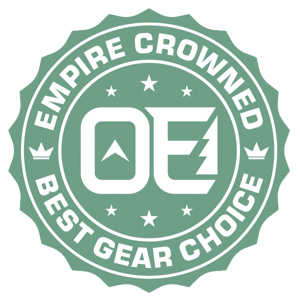
If you’re willing to spend another $100-300, you can definitely get a more rugged rangefinder, or one with longer range, more functions, better optics, and maybe some bells and whistles. But do you need that?
That’s what it came down to for me. I was interested in some of the more expensive options. But the fact is that I wouldn’t use most of the features they have.
However, more technical long-range hunters/shooters, gear geeks, or people who are really hard on their gear might be better off looking at a higher grade of a rangefinder.
Or, on the contrary, if you have a really limited budget and need the cheapest functional rangefinder possible, there are some decent options for around $100 or a little less. These are no-frills and basically, only give you a distance measurement.
If you like what the RX-1400i does but you’re looking for a step up, you can’t go wrong bumping up to its big brother, the Leupold RX-1600i TBR/W. For twice as much money, you’ll have more range, more rugged housing, and better glass. For $600, the RX-2800 TBR/W is about as good as it gets with double the range.
At the end of the day, I just need to know how far my target is to dial in a shot or how far that next ridge is so I can guesstimate how long it’ll take me to hike over there.
The Leupold RX-1400i does that and then some. I like it. I’ll keep using it. And I recommend it for any other practical hunter out there.
- Red display is easy to see in any light condition and is unique at this price
- Easy to use and operate with solid documentation
- Sufficient range for most hunting and shooting uses
- Has more and better features than any other rangefinder for $200 or less
- Ballistics functions are great for both rifle and bow hunters
- Compact form factor and lightweight make it easy to pack around
- While waterproof, it’s not super rugged
- Only a measly 2-year limited warranty, not near as good as the competition
Compare prices at: Cabela’s, Bass Pro Shops, Sportsman’s Warehouse

